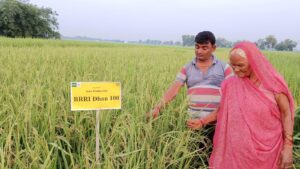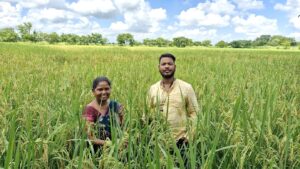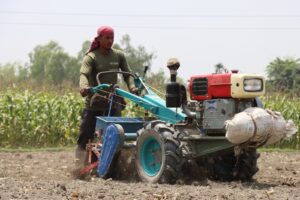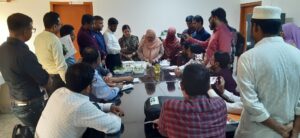
Improved rice varieties and technologies have more than once saved many nations from sure famine. However, as world population continues to grow and rice production struggles to cope, new ways of multiplying global food resources are needed.
The boy who cried C4
Somewhere near London, during World War II, a boy to be named John Sheehy was born. More than 60 years later, the world finds him waving a flag, not in surrender to this era’s woes, but to rally support for an idea that just might become this generation’s best shot against hunger—C4 rice.
C4 rice is the ultimate goal of rice scientists’ attempt to supercharge photosynthesis—the process by which a plant uses sunlight, carbon dioxide, and water to produce carbohydrates—in rice so that it yields more grain. Rice, a C3 plant, uses these resources far less efficiently than C4 plants (e.g., maize) do. A C4 rice plant would use less water and fertilizer and produce at least 50% more grain.
A hairy idea
Hypothetically, if one can change an organism’s metabolism so that more of the raw materials captured can form useful tissue and less goes to waste, crop yields would increase. Rice, the staple food of millions in Asia and Africa, must be first in line for the makeover.
The C4 rice idea was met with measured enthusiasm and, quite predictably, much skepticism. But John always knew that this whole concept of modifying photosynthesis in rice needed some stout defending. So, he thought that a little “extreme breeding” couldn’t hurt.
John was convinced that C4 rice was possible, and he made such a good case that a project and the C4 Rice Consortium —a group of a group of brilliant scientists from advanced research institutions around the world—were soon established. In fact, this once big hairy idea is now supported by the Bill & Melinda Gates Foundation, which provided US$11 million to further the research.
Artsy academic

John was born of Irish parents, who met in England just before World War II broke out. His father was then in the Royal Air Force. During the war, John’s mother took him to her family’s farm in Ireland to escape the bombing. After the war, the family moved to Wales.
Despite spending some of his early years on an 80-hectare farm in Ireland, John did not have the remotest brush with agriculture in college. At the University College of Wales, he studied physics and went deeper into it before he picked agricultural botany as a Nuffield Foundation Fellow to study alongside physics for his Ph.D.
Though largely an academic, John was always interested in the creative side of things. While steeped in physics in university, he also got involved in drama and dreamed of doing memorable work in advertising. And he eventually did his bit. A little-known fact is that he, with others on a public relations committee many years later, came up with the International Rice Research Institute’s (IRRI) enduring slogan, “Rice science for a better world.”
“Perverse scientist”
Some think that John Sheehy’s signature peach and pink shirts and his easy manner are a ploy to dilute hostile attention. Those who know John beyond those gentle hues know that he is anything but mellow. A case in point is his quite popular 1999 paper, The universe, the evolution of the perverse, and a rice problem—John’s 18-page treatise on how a scientist in this age of cost-efficiency and milestones tends to find more roadblocks than inroads to discovery and invention.
“That perverse paper,” as it has come to be known, was also a commentary that reflected his unorthodox views on research, scientists, and organizations. John saw that, on the way to becoming a system and a structure, the science of the Consultative Group on International Agricultural Research (CGIAR) nearly lost its most valuable tool—creativity.
Creativity, John explains, is not continuous but occurs in bursts—something that modern science management somehow ignores in its institutions. Scientists have well-equipped laboratories and modern tools, but all too often too little room to think and maneuver outside of their assigned projects.
“Science is a highly creative discipline,” he declares in the paper. John posits that scientists, if they are to be true to their vocation, must try to resist the tyranny of data accumulation (measure everything you can think of and the answer will be found) and discipline their thoughts to be creative—hence, perverse.
“Scientists who would be inventive tend to be difficult,” John elaborates, “and great organizations like IRRI have to accommodate that.”
The paper included an example of how a simple change in approaching scientific problems could overturn even long-held scientific theory, such as when John’s team discovered that rice is triphasic and not biphasic, as universally believed.
It was not the first time that John disproved something that was somewhat set in stone in modern science. Previously, while he was in the UK, John and his team uncovered a major error in the technique widely used for measuring nitrogen fixation and went on to discover what controls nitrogen fixation in legume root nodules.
John believes that the genuine test of a theory would be an attempt to falsify it, and his penchant for questioning accepted theory did not exactly make him the darling of rice research. He confessed that, although some of his peers were impressed by his views, he also alienated himself. “I have had some lonesome moments,” he laments.
Rock star
Despite John Sheehy’s lone-ranger tendencies, the people who worked with him credit their strong and close-knit team to their former leader. “John is the type of boss who listens,” says Jacque Dionora, senior assistant scientist of the C4 project. “He lets every member of his crew—down to the humble research technician—know that his tasks and opinions matter.”
Naids Ferrer, assistant manager for the project, sheds light on an old coffee shop mystery in IRRI: “John always spends for our Christmas celebrations. But when the team grew in number, we could no longer let him shoulder the costs. So we started raising money by making everyone on the team wear a certain color for each day of the week and violators had to pay a fine.
“In those days, John often took the whole crew to the IRRI coffee shop,” continues Naids. “People would stare because we were in line for coffee all wearing the same color. Such gestures increased team morale, and we developed a bond with John that we knew was the envy of many research staff. That was priceless.”
After IRRI
John had already planned to keep himself busy in retirement—help his daughter run her PR company, learn more about his grandparents, enjoy good wine in Italy and learn the Italian language, polish his French, and hunt down old friends in Wales. John will be at IRRI for three months each year as a consultant for the C4 rice project and he resolves to continue to play golf on the side as much as tropical weather permits.
“Foresee”
At the beginning of his career, in his Ph.D. studies, John concluded that in the quest for higher yields it would be better to select for erect leaves rather than leaf photosynthesis. He finds it ironic that—although that strategy was correct—he ends his career seeking to supercharge photosynthesis to make the next quantum leap in yield.
Note that “C4” is pronounced “foresee” in reverse. The idea holds great promise, and the fact that it is actually getting support is an example of the collective “fight” instinct of international agricultural research. How does John feel about this?
“It’s nice to leave with a success,” he says simply.
John retired in July 2009 as head of the Applied Photosynthesis and Systems Modeling Laboratory in IRRI. He leaves IRRI, after 14 years, with more than blueprints for a whole new kind of rice plant. He leaves a teaser for better times ahead.
___________________________________________
Ms. Baroña-










